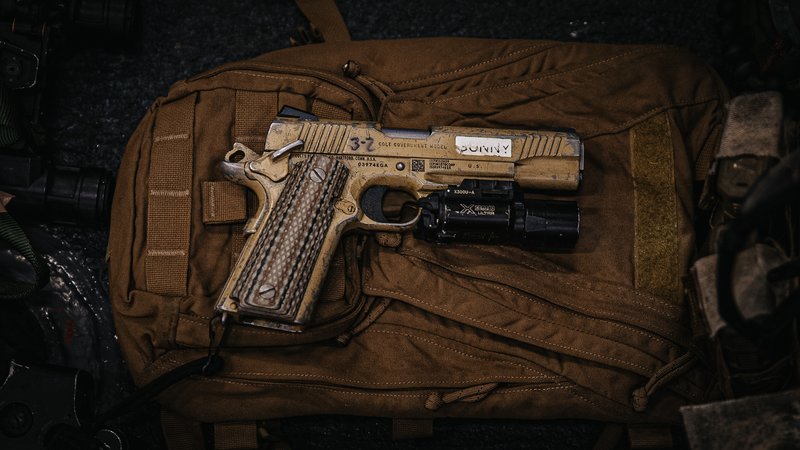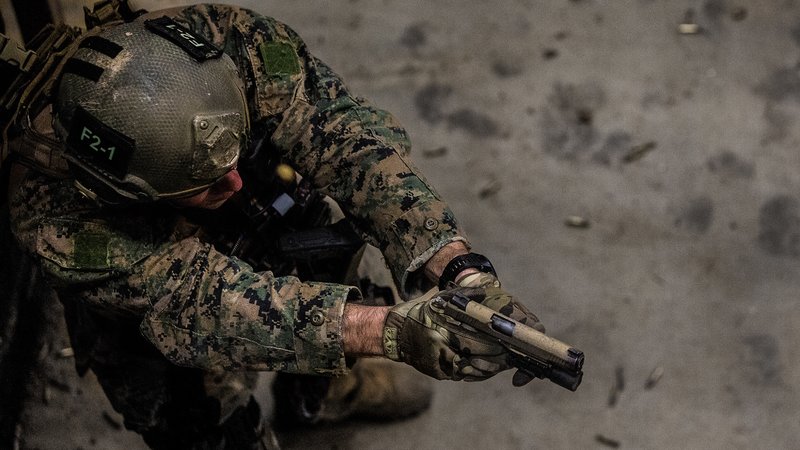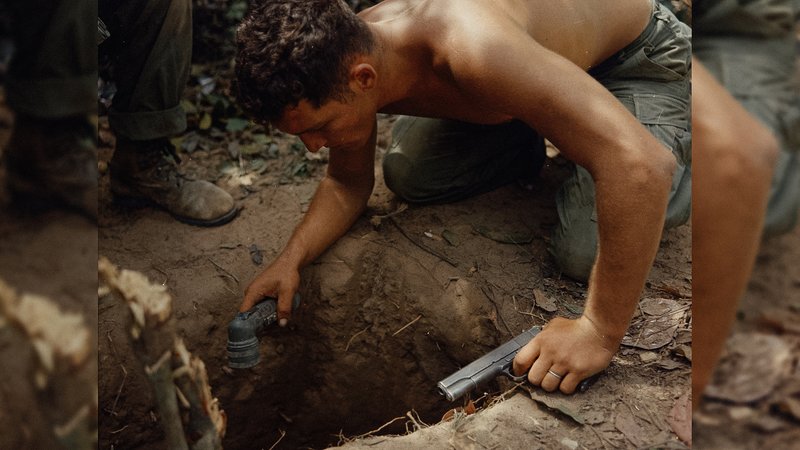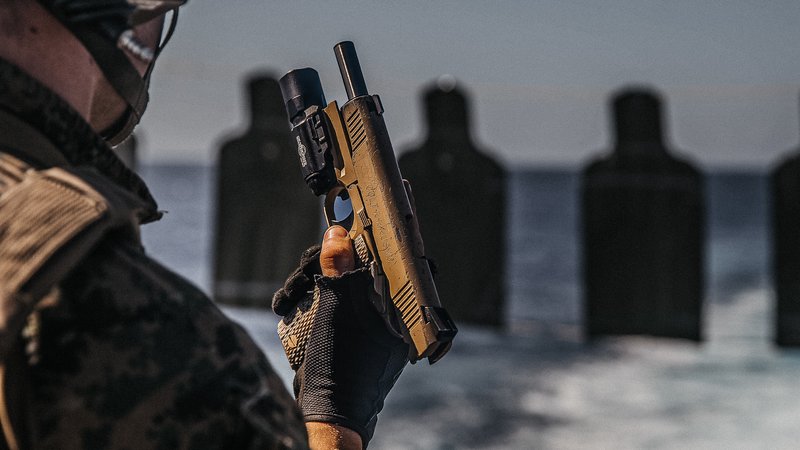
Lance Cpl. Benjamin Jiminez, a reconnaissance Marine, with 3d Reconnaissance Battalion, 3d Marine Division, conducts a shooting drill during Close-Quarters Battle training at Camp Schwab, Okinawa, Japan, on Jan. 26, 2021. US Marine Corps photo by Sgt. David Staten.
The Marines are finally ditching the M45A1 Close Quarters Battle Pistol. The iconic steel-frame sidearm — the Corps’ latest (and now last) iteration of the M1911 pistol — is being replaced by the SIG Sauer M18. After more than 100 years of faithful service, the big iron’s days of riding on the hips of service members are coming to an end.
At the turn of the century, the United States Armed Forces sought an automatic pistol to replace the myriad revolvers American troops had carried ever since Colt Dragoons first saw action during the Mexican-American War in 1846. Following the American Civil War, the Army led the way in a hunt for a reliable self-loading sidearm.
In 1900, they purchased 1,000 Lugers chambered in 7.65mm Parabellum, but a series of field tests revealed the round’s inadequate stopping power. During the Moro Rebellion, American troops armed with single-action M1892 revolvers chambered in .38 Long Colt reported that enemy soldiers continued to attack even after being shot several times. Following the war, the Army set off to find a semi-automatic pistol that fired a large-caliber bullet.

An M45A1 pistol is laid out on top of a Force Reconnaissance Marine’s loadout prior to a visit, board, search and seizure (VBSS) operation aboard the amphibious assault ship USS America (LHA 6), Philippine Sea, Feb. 2, 2022. US Marine Corps photo by Lance Cpl. Cesar Ronaldo Alarcon.
The Army held a series of trials between 1907 and 1911 to determine which pistol should become its official sidearm. The competition eventually boiled down to the Colt 1911, designed by John M. Browning, and the Savage 1907, both chambered in the .45 ACP cartridge. A final stress test, in which 6,000 rounds were fired from each of the pistols over two days, revealed the Colt to be the superior weapon. When the Colt’s barrel began to overheat, simply dunking it in water sufficiently cooled the weapon with no obvious detriment to its accuracy or reliability.
In March 1911, the first pistols — officially dubbed the Model 1911, or M1911 — were issued to soldiers. The Navy and Marine Corps adopted the M1911 two years later.
Related: The M203 Grenade Launcher: Farewell to Infantry’s ‘Little Friend’
The M1911 Goes to War
American service members carried M1911s throughout both World Wars, the Korean War, and the Vietnam War. Although weighing nearly 2 1/2 pounds and measuring more than 8 inches in length, the heavy steel pistol was comfortable to shoot because of its slim, ergonomic design. The M1911’s short-recoil action and seven-round single-stack magazine made it exceptionally reliable for a sidearm. No longer was a soldier’s pistol merely a last-ditch weapon.
On Oct. 8, 1918, US Army Sgt. Alvin York demonstrated that the M1911 could hold its own against shoulder-fired and belt-fed weapons. While leading a team of seven infantrymen, York attacked a network of German machine gun positions that were pinning down his battalion.

A force reconnaissance Marine team leader with Maritime Raid Force, 31st Marine Expeditionary Unit, scans a room during close quarters training at Camp Hansen, Okinawa, Japan, Feb. 27, 2017. US Marine Corps photo by Cpl. Jona R. Meme.
When a group of German soldiers advanced on York and his men, he drew his M1911. Firing six rounds in rapid succession, he shot and killed six enemy soldiers. The rest surrendered. As York escorted the Germans back to friendly lines, M1911 still in hand, more began to surrender. By the time York returned to his unit, he had captured 132 Germans.
Colt updated the M1911 in preparation for World War II. Portions of steel were cut out from the frame to lighten the weapon’'s overall weight, the trigger was shortened, and a wider front site was added. It was also outfitted with a longer grip safety spur to prevent the hammer from pinching the shooter’s hand, and it was given a more ergonomic mainspring housing.

A Marine Corps Air Station Miramar Special Reactions Team (SRT) member poses for a photograph during training at MCAS Miramar, California, May 15, 2019. The Marines conducted this training to hone their skills in close quarters combat and further familiarize themselves with the M1911 Service Pistol. US Marine Corps photo by Sgt. Jake McClung.
Nearly 2 million updated pistols — officially dubbed M1911A1s — were manufactured and issued to American troops during the war. From infantry attacks to bombing raids, nearly every job in the US military was carried out with the added protection of an M1911.
Although already beloved by GIs, the M1911 really proved itself as an exceptionally reliable weapon during the Korean War. In the mountains and cities of Korea, fighting was regularly done at close quarters and in sub-zero temperatures. Following a tour of the frontlines in the winter of 1950, Brig. Gen. S. L. A. Marshall, analyst for the US Eighth Army, noted, “One hears more words said of [the M1911’s] proved usefulness than during either World War.”

Cpl. Ronald A. Payne, Company A, 1st Battalion, 5th Mechanized Infantry, 25th Infantry Division, checks a tunnel entrance in Cu Chi, Vietnam. Jan. 24, 1967. Photo courtesy of Wikimedia Commons.
The M1911’s reputation as an ideal weapon for close-quarters combat was only further cemented in Vietnam. There, beneath the jungled battlefields of Southeast Asia, “tunnel rats” typically carried nothing but a flashlight and their trusty M1911s when crawling underground to face the Viet Cong alone in cramped tunnels.
Related: The Goose Is Loose — How the Carl Gustaf Recoilless Rifle Changed the Game
Arrival of the 9mm
In spite of the M1911’s proven success, the US military began looking for its replacement immediately following the Vietnam War. With recent advancements in firearms ammunition, the armed forces wanted a weapon capable of carrying more rounds than the M1911 could, and that also had a more manageable recoil. By 1985, both the Air Force and the Army had replaced their arsenals of M1911s with Beretta pistols chambered in 9mm.

A Marine with the Maritime Raid Force, 26th Marine Expeditionary Unit (MEU), reloads an M45A1 combat pistol during combat marksmanship training aboard the USS Oak Hill (LSD 51) while underway in the Atlantic Ocean, Feb. 19, 2018. US Marine Corps photo by Cpl. Austin Livingston.
By the 1990s, the Beretta M9 had almost completely replaced the M1911. Some units — namely, Army Special Forces, Navy Seabees, and Marine Force Reconnaissance Companies — continued to carry the M1911 in an updated design known as the M45 MEU(SOC).
In 2017, the Army announced that the SIG Sauer M18 would replace the Beretta M9 as the branch’s standard-issue sidearm. The Navy, Air Force, and Marine Corps followed their lead and also adopted the M18. However, five years earlier, the Marine Corps had purchased 4,036 new M1911s, designated as M45A1s. Not wanting to discard the weapons, the Corps issued the old Colt warhorse to Recon Marines.
Now, after 123 years of service, the M1911 is being fully retired from the US military.
Read Next: Swift, Silent, Deadly: Where Does Marine Recon Stand Among Other Elite Units?

Mac Caltrider is a senior staff writer for Coffee or Die Magazine. He served in the US Marine Corps and is a former police officer. Caltrider earned his bachelor’s degree in history and now reads anything he can get his hands on. He is also the creator of Pipes & Pages, a site intended to increase readership among enlisted troops. Caltrider spends most of his time reading, writing, and waging a one-man war against premature hair loss.
BRCC and Bad Moon Print Press team up for an exclusive, limited-edition T-shirt design!
BRCC partners with Team Room Design for an exclusive T-shirt release!
Thirty Seconds Out has partnered with BRCC for an exclusive shirt design invoking the God of Winter.
Lucas O'Hara of Grizzly Forge has teamed up with BRCC for a badass, exclusive Shirt Club T-shirt design featuring his most popular knife and tiomahawk.
Coffee or Die sits down with one of the graphic designers behind Black Rifle Coffee's signature look and vibe.
Biden will award the Medal of Honor to a Vietnam War Army helicopter pilot who risked his life to save a reconnaissance team from almost certain death.
Ever wonder how much Jack Mandaville would f*ck sh*t up if he went back in time? The American Revolution didn't even see him coming.
A nearly 200-year-old West Point time capsule that at first appeared to yield little more than dust contains hidden treasure, the US Military Academy said.












